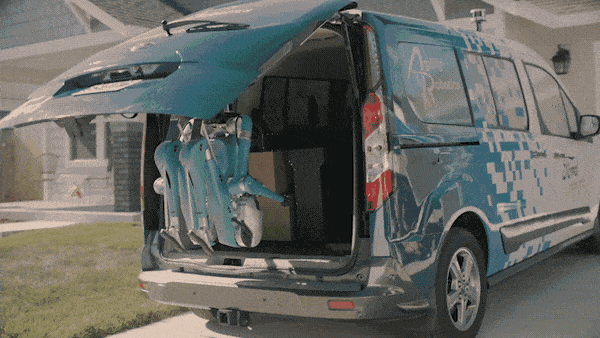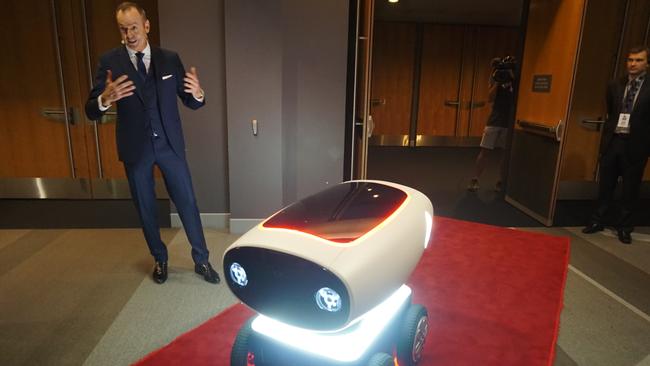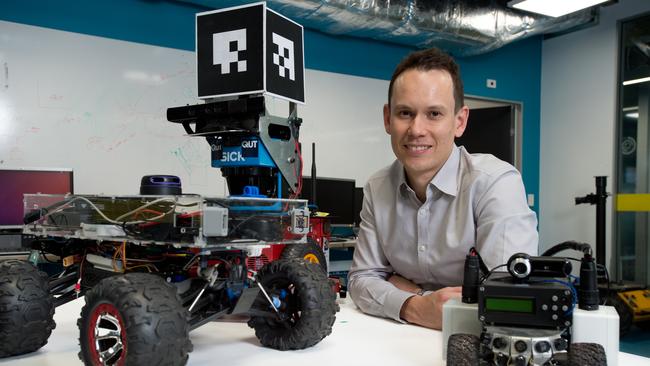Robots face the money test
Delivery robots are yet to pass the test of being commercially viable.

Delivery robots are yet to pass the test of being commercially viable, says an Australian robotics vision expert.
Organisations and retailers are testing a myriad of delivery robots. Some look like eskies on four or six wheels, rolling along pavements, crossing roads and climbing gutters en route to destinations. Some are more traditional robots that walk on two legs and even climb stairs.
Are we going to see them coming to suburbs near us?
In the US, robots by delivery service DoorDash have undergone more than 32,000km of testing. In 2016, Australia Domino’s announced plans for a similar robot called DRU. It also announced DRU Drone, pizza delivery by drone.
In the US, Amazon has been testing its six-wheel Scout delivery robot. It told The Verge this week that it had created detailed virtual maps of American suburbia so that it can run thousands of simulated deliveries. It says this will speed up deployment.
“Last mile” robots not only might deliver groceries and takeaways, but medicines and general packages to your door.

This year Ford unveiled an ambitious plan to place a foldable robot in the back of driverless vans.
The robot, Digit, unfolds when the van reaches a delivery address, and carries the delivery package to the door. Digit walks on two legs like a human, and according to Ford, the robot can avoid obstacles and even scale staircases. Digit can lift 18kg, manage uneven terrain, and compensate for being thrown off balance.
Ford vice president and chief technology officer Ken Washington detailed the operation of Digit in the online publishing platform Medium.
Dr Washington says Ford is partnering with Agility Robots, a spin-off from Oregon State University, which was set up to commercialise robots from the Dynamics Robotics Laboratory.
“Since self-driving vehicles can potentially move people and goods simultaneously, they hold great potential to make deliveries even more convenient and efficient,” Dr Washington says in Medium.
“It’s not always convenient for people to leave their homes to retrieve deliveries or for businesses to run their own delivery services.”
Australian Centre for Robotic Vision chief investigator Michael Milford says these delivery robots are likely to be safe. They are not dangerous provided they move at low speeds. They’re generally small and can be extremely cautious negotiating unknown environments, he says.
The issue is more whether they are commercially viable. “My prediction, with not a lot of certainty, is that it's probably not going to be particularly commercially attractive to do this,” Professor Milford tells The Australian. He says that’s unless companies discover a market where people pay more for a better or faster delivery service.
“These things could be running 24 hours a day, 365 days a year. Once you've done the R&D, once you've got a viable product, the capital cost is probably not that significant. It's whether as an ongoing concern it’s viable. Delivery drivers are very fast and very effective and reasonably reliable.”
Professor Milford says the likely best solution could be robots work alongside a human at a delivery location.
“They (the human) can do the whole street in a fifth of the time, and that's sort of a more affordable intermediate scenario, because they have four of these robots helping them.
“Humans are very good at filling in those one in 100 houses where the robot for whatever reason can't do it autonomously.”
He says delivery drones and delivery robots may work best in small communities where access is less complicated. “But none of these companies care about that. They need this to be something that is widely deployable under a very wide range of conditions, and that's where the big question mark on most of these technologies is.”
He cited other autonomous delivery models, such as US grocery chain Kroger’s use of autonomous vehicles developed by robotics firm Nuro. “They have a larger, autonomous on-the-road vehicle with no people inside it. You pay $US5 95 to get your groceries delivered to you. It turns up at the kerb, and you physically have to go out and get it.
“We don't know yet whether it's going to be worth the extra money for the thing to actually drop it at your door, or whether some people will tolerate the model where you have to go down to the kerb and pick it up.”
This sounds more an automated form of the home deliveries by Woolworths and Coles. The autonomous delivery truck would turn up and you’d need to be available to meet it.

Professor Milford says there’s another use for Ford’s foldable robot in the back of an autonomous van. It could assist elderly people at pick-up and drop-off points.
“They may be able to help with these other things around mobility which just autonomous cars by themselves can’t help you with.”
Domino’s seems to have moved away from the concept of dozens of DRU robot thundering down streets delivering pizza, to using software to improve the quality of its pizzas in-store.
In a statement to The Australian, Domino’s says demand for deliveries will ultimately outpace the supply of deliverers, which is why exploration with robotic technology is not only extremely important but necessary.
“Investing in technology that coexists with our team members to help create efficiencies in this space is extremely important to us,” a spokesperson says.
“It’s for this very reason that we have also completed deliveries using autonomous, ground-based robots in selected inner-city areas in our European markets and why we are working closely with the experts in drone delivery, Flirtey, in New Zealand having already completed the first commercial delivery of food by drone to a customer.
“It’s fair to say that DRU has significantly evolved over the past three years at Domino’s. It has now transformed into DOM, and DOM now represents all of our work in the AI and robotics space, with DOM Pizza Checker the latest addition to the family.”
Certainly, we haven't seen swarms of DRUs running around Australian streets in the three years since its launch.
It’s a case of the possible versus the viable — as the march to get robots into the retail and delivery world multiplies.



To join the conversation, please log in. Don't have an account? Register
Join the conversation, you are commenting as Logout